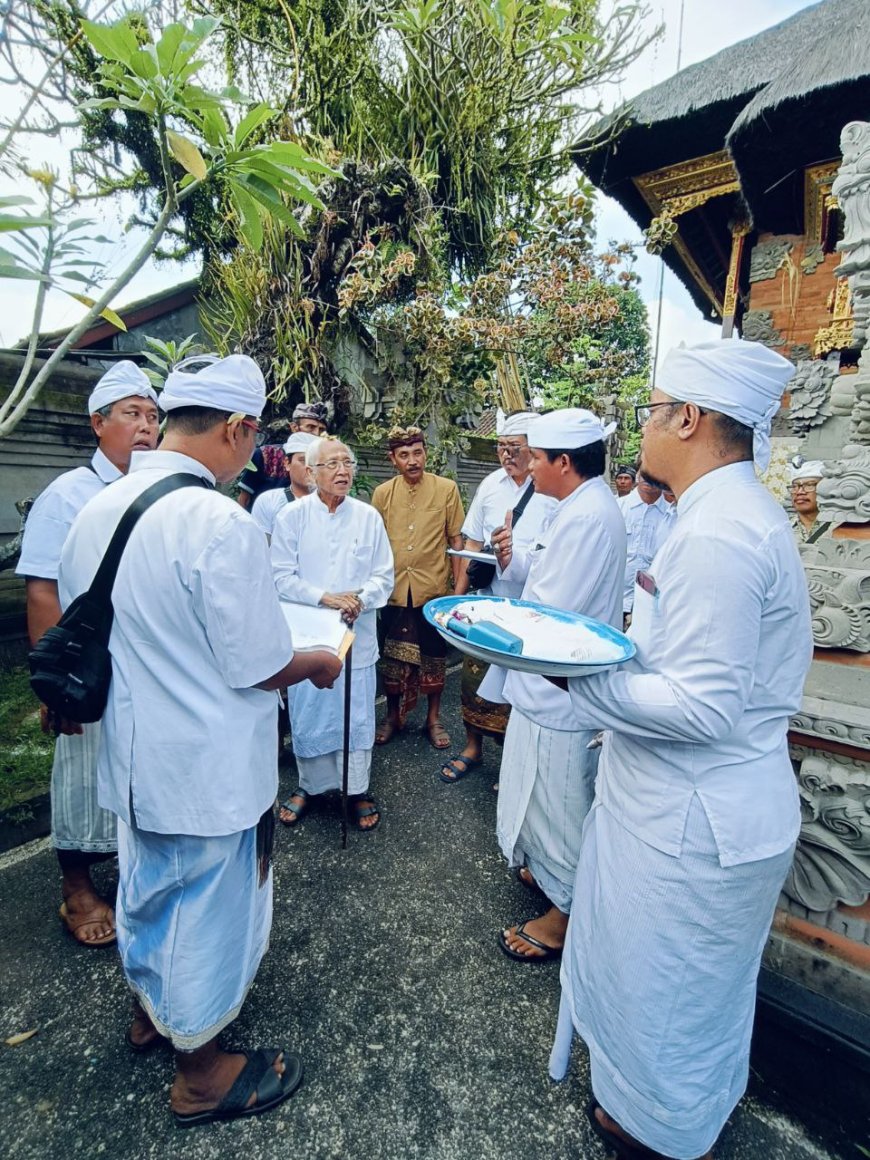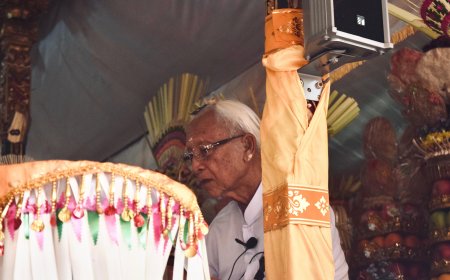Nyukat Genah: Balancing Earth and Spirit in Balinese Ceremonies
Nyukat Genah is a manifestation of Balinese local wisdom that emphasizes harmonization between humans and nature in every aspect of life, including physical construction. This practice ensures that every building erected not only has physical function but also spiritual significance, thereby providing positive impacts for the entire surrounding community.
Still in the series of preparations for the Karya Agung Ngenteg Linggih, Ngusabha Desa, and Mapahayu Nini ceremonies, at Pura Desa and Puseh, Desa Adat Mengwitani, Mengwi, Badung Regency, on Sukra Umanis Klawu day, June 28, 2022, the Nyukat Genah ceremony was held. This ceremony aims to determine and mark the exact location for various supporting elements of the grand ceremony. The Nyukat Genah procession was led by Ida Pedanda Putra Pasuruan as Yajamana Karya, accompanied by Ida Pedanda Istri Parwati Kemenuh as Tapeni, the pemangku, the Kelian Desa Adat, the Serati, and the Prawartaka Karya.
Nyukat Genah is one of the important parts of the series of customary and ritual ceremonies in Bali. Nyukat Genah literally means "measuring the place" and is carried out to determine the precise and harmonious location for the construction of sacred structures. Nyukat Genah is usually related to the construction of holy places and major religious ceremonies. In the context of building holy places, Nyukat Genah is carried out before starting the construction of temples or other sacred buildings to ensure that the chosen location aligns with the principles of balance and harmony in Balinese Hindu teachings. This includes considerations of astrological, topographical, and geographical aspects that are believed to influence positive energy and the well-being of its inhabitants.

The Nyukat Genah Ritual
Meanwhile, in relation to major religious ceremonies such as ngenteg linggih or other religious ceremonies, Nyukat Genah plays a crucial role in determining the right place for supporting elements of the ceremony. Choosing the correct location is considered very important for the smooth execution of the ceremony and to be well received by the gods. Therefore, Nyukat Genah not only ensures the physical continuity of the building or ceremony site but also maintains a harmonious relationship between humans, nature, and their spirituality.
In the context of Nyukat Genah and construction in general, the primary references are the Lontar Asta Kosala Kosali and Lontar Asta Bhumi. Lontar Asta Kosala Kosali contains detailed guidelines on the layout and orientation of buildings, including residences and temples, based on principles of balance and harmony in Balinese Hindu teachings. This guide helps ensure that each building is constructed according to the correct physical and spiritual aspects, creating a harmonious and prosperous environment for its inhabitants. Meanwhile, Lontar Asta Bhumi provides instructions on land division and determining suitable locations for various types of buildings and ceremonies. This lontar considers topographical aspects and other important elements that must be considered to achieve a balance between humans, nature, and God. By referring to these two lontars, the Nyukat Genah process and construction in Bali are carried out meticulously, preserving the traditions and local wisdom passed down by the ancestors.
The Nyukat Genah process involves several stages, including:
1. Location Determination: Identifying and determining the place to be used based on customary and spiritual guidelines. This location must comply with Balinese cosmological principles related to the balance of the universe.
2. Measurement and Calculation: Measuring the land and performing precise calculations to ensure that the size and shape of the place to be built align with customary regulations. This includes calculations of cardinal directions, the position of the sun, and other natural elements.
3. Ritual Ceremony: Conducting a series of ceremonies led by customary leaders or priests (Sulinggih). These ceremonies aim to seek permission and blessings from the gods and ancestral spirits so that the construction process goes smoothly and the place brings prosperity.
4. Symbols and Markers: Establishing symbols or markers on the measured location as guides and markers for the construction workers. This is usually done by planting sticks or stones at certain points, or with other means such as flour to provide a symbol or mark.


The Ngeruak Ritual Initiates the Nyukat Genah Process
The Nyukat Genah procession at Pura Desa and Puseh Desa Adat Mengwitani began with the Ngeruak ceremony, using caru ayam brumbun led by the Pemangku. Literally, "Ngeruak" means digging or opening the ground. This ceremony has profound meanings involving spiritual, symbolic, and ecological aspects. Here are some of the main meanings of the Ngeruak Ceremony:
1. Asking Permission from Dewi Pertiwi: In Balinese Hindu tradition, the land is considered a manifestation of Dewi Pertiwi (earth goddess). The Ngeruak ceremony is conducted to seek permission and blessings from Dewi Pertiwi so that the land to be dug and used can bring benefits and not cause disturbance or anger from the spirits inhabiting the place.
2. Harmonizing Energy: Through this ritual, it is hoped that there will be harmonization between natural energy and human energy. This ceremony aims to balance and cleanse negative energy that may exist at the location to be built, allowing positive energy to flow smoothly.
3. Protection and Safety: Ngeruak is also performed to seek protection for the workers involved in the construction process. The prayers and offerings aim to avert disasters and ensure safety during construction.
4. Cleansing and Purification: This ritual is also considered a process of cleansing and purifying the land. By performing Ngeruak, the place to be built is expected to become sacred and suitable for constructing buildings with high spiritual value.
The supporting elements of the ceremony, produced from the Nyekah Genah process as part of the Ngenteg Linggih, Ngusabha Desa, and Mapahayu Nini ceremonies, include:
Main Mandala (Utamaning Mandala): Sanggar Luhur Akasa, Sanggar Tawang, Sanggar Rsi Gana, Sanggar Tirta and Pengrajeg Karya, Sanggar Penyejeran Pelinggih, Lumbung, Surya Lumbung, Linggih Petapakan, Linggih Ida Bhatara Kahyangan Tiga and Pepeletan, Asagan, Paselang, Sanggar Siwa Budha, Pawedan, and Sanggar Pahayu Nini.
Middle Mandala (Madyaning Mandala): Sanggar Rare Anggon, Sanggar Yama Raja, Sanggar Surya Ngusabha, Asagan Kuri Agung, Sanggar Siwa Budha Bujangga, Sanggar Luhur Akasa, Sanggar Tawang, and Bale Timbang.
Outer Mandala (Nistaning Mandala): Pengubengan, Bale Padanan, Pawedan, Genah Ngusabha, Bale Barong, and Jegeg Bagus.
Nyukat Genah is a manifestation of Balinese local wisdom that emphasizes harmonization between humans and nature in every aspect of life, including physical construction. This practice ensures that every building erected not only has physical function but also spiritual significance, thereby providing positive impacts for the entire surrounding community.



































































